General Information
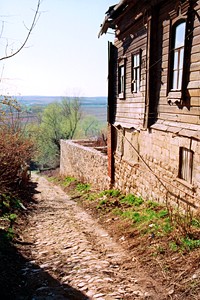 |
Zaraysk.
In front of a zaraza.
Photo: A.Tilipman |
Some historians relate the name of the town to the tragedy which took place here in the distant year 1237. At that time, the town was known as Krasny and was ruled by prince Feodor - a son of Yury, prince of Ryazan'. When the town was being taken by Tartars, Evpraksia, the wife of Feodor, to avoid being captured, grabbed her baby son, jumped out of the window of her tall palace, and fell to her death. In Old Russian, to fall to death is zarazit'sya. Since then, presumably, the place got the name of Zarazsk, which eventually transformed into more euphonic Zaraysk.
The same root, zaraza, was also used in Old Russian to denote a rough, ravine lanscape, as stated in the influential Dal' Dictionary of Russian Language. This is where the second hypothesis on the origin of the town's name comes from. Indeed, it is hard to deny that the entire right bank of river Osyotr is essentially a huge zaraza. If one jumps down from it, it is quite easy to zarazit'sya (to fall to death) even without a tall princess' palace.
A traveller with some experience in Soviet History could make an analogy with another district center of Moscow Region - Sergiev Posad. This town for almost 70 years was called Zagorsk, which sounds like a genuine ancient Russian name, but originates in fact from the bolshevik comrade Zagorsky. One could assume, analogously, that Zaraysk owes its name to an important Communist party leader comrade Zaraysky. Though, indeed, very likely looking, this version is really beneath all criticism.
Thus, during 800 years of its history Zaraysk changed the name many times. As we already mentioned previously, the first chronicles call it Krasny. In 14th and 15th centuries it is mentioned as Novogorodok-na-Osetre. In 1528, a stone cathedral devoted to St. Nicholas the Wonderworker was built in the town; since this moment, the latter obtains the name of Nikola-Zarazsky. The next more than two centuries enriched its Curriculum Vitae by some more variations on the theme of zaraza - Zarazsk, Zarazsky Gorod, Zaraskoy. Finally, about 18th century the local population finally broke their tongues and produced a decisive interpretation of the original name.
It is interesting that, despite certain ideological weakness of its name - Zaraysk sounds like "behind the Paradise", which was clearly not appreciated at the time - the town had a luck to be never renamed during Soviet times. However, it had to change the "affiliation". Even though since 1778 Zaraysk was an uezd (district) center of Ryazan' guberniya (province), in 1937 it becomes the center of Zaraysk district of (now) Moscow region. This shift of the province boundary can not be really regarded as logically justified - Ryazan' is approximately twice as close to Zaraysk as Moscow.
Instead of looking for logical in the internal policy of 1937, let us have a walk along local streets. Their names evoke nostalgic feelings even from not the oldest generation of Muscovites - Dzerzhinsky, Karl Marx, Revolution Square, Pervomayskaya. You really want to transfer to a connecting subway line or at least to mind the gap. But why are we talking about Moscow all the time? In Zaraysk there is something which is long gone in Moscow - this is Osyotr, which means "sturgeon" in Russian.
Great Osyotr is powerful and dreadful! It flows freely between boundless Zaraysk fields, but it feels tight between high steep hills. In a blind fury it undermines the banks, blows off road bridges, abuses the district treasury and the patience of the locals. The only good thing about it is that it produces these outrages exclusively during the spring high water, but if this happens, you may be sure to think it is more than enough. In April 2003, River Osyotr has risen 6 meters, destroyed two road bridges, and flooded one more. If you travel to Zaraysk in Spring, be sure to check the current situation.
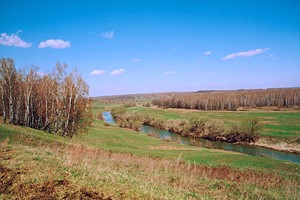 |
River Osyotr.
Photo: A. Tilipman |
We must say that recent history contributed considerably to the conservation of the appearance of this pretty provincial town. Highways and principal railroads lie far from the town, and residential and industrial areas built in 20th century hardly invade the historical town center. Besides, due to the large distance from Moscow, vicinities of Zaraysk are not yet as actively taken over by dacha owners as many others places around Moscow.
Thus, the area of modern Zaraysk is fairly well split into parts differing by their purposes: historical center, administrative center, flat buildings from Soviet times, and industrial area. The two latter make about three kilometer long strip along the railroad in the direction Lukhovitsy. This is why the entrance to the town from the direction of Moscow is not really attractive.
The road continues along concrete fences until it comes to the old part of the town and ends at the central square. It is now a mixture of old trading arcades, new trading stalls, the bus station, and, of course, the flea market. A bit further one finds the main attraction of the town - Kremlin, and at the opposite corner of the square - the Regional Museum (Phone 2-27-34; 11 - 17 daily except Monday and the last day of the month). After walking around the square, the most sharp-sighted can glimpse a sight of all churches and many other attractions of the town; the most hungry can procure food at anyone's taste; and the most impatient can afterwards get into a bus or a car and immediately drive away. The most inquiring minds, however, can walk in any direction from the bus station: Whatever direction you take, you certainly encounter something interesting.
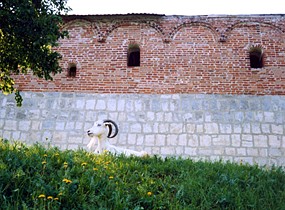 |
A goat.
Photo: I. Gurevich. |
Despite certain negligence and, to say it mildly, an inattentive attitude of the town authority to the historical monuments (see below), Zaraysk managed to preserve the striking individuality. Its historical and geometrical center is Kremlin with its cathedrals, situated at the confluence of River Osyotr and River Monastyrka. Kremlin naturally connects the two parts of the old town - "regular" Zaraysk and "zaraza" Zaraysk.
Whereas "regular" Zaraysk was built on a relatively flat land and for this reason could not avoid an application in 1778 of a rectangular grid, "zaraza" Zaraysk, built on zarazas, had a much greater luck. "Zaraza" Zaraysk is an entirely different world, which hardly resembles the "correct", "regular" Zaraysk. Labyrinths of streets getting lost in the weeds, lop-sided wooden houses and fences, narrow beaten paths, making together a fantastic network …
Surely, here you can find only a few of rich merchant mansions, which are so abundant in the "regular" part of the town. However, it is precisely these one-floor wooden buildings which determine the spirit of the old Zaraysk.
The very same zaraza landscape helps to appreciate fully the beauty of Zaraysk. Zaraysk owes many nice panoramic views to this relief. Distant meadows behind River Osyotr, reaching the horizon; small wooden houses, shaped on the slope of the hill; tops of towers and churches - everything is a delight to an eye.
Especially, if you look from far away.
 |
Panoramic view of Old Zaraysk.
One can distinguish all 7 Kremlin towers, and 4 out of 5 town churches.
Photo: A. Tilipman |
History
From the foundation to 1237 Zaraysk, situated at the border between the Great Steppe and the woodlands, regularly became a victim of raids and plunders. In 1237, it happened to be on the way of Batu Khan army during its offensive to Vladimir and got burned.
Considerable changes in the towns's life occurred in the first quarter of 16th century, when it was appended to Moscow, together with other Ryazan' lands. As well as of other fortresses of the Great Zaseka line (the Southern border of the Moscow state, separating it from the Great Steppe), from Pereyaslavl' Ryazansky to Kozel'sk and Belev, its destination was to protect Moscow from numerous Tartar raids. At this time, the town was fortified by earthworks, ditches, and wooden ramparts with seven drive-through and five blind towers, which got the name of Ostrog.
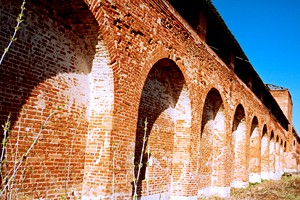 |
Zaraysk. Kremlin.
Photo: A. Tilipman |
Even more, in 1528 Vasily the Third, the Great Prince of Moscow, makes a decision that one more, stone, fortress has to be built inside the Ostrog. This additionally emphasized the strategic importance of the town. After the stone Kremlin was built, Tartars approached the town several times - in 1533, 1541, 1544, 1570, and 1591. The Kremlin was invariably unassailable, whereas the surrounding areas were plundered.
Smuta, the Time of Troubles, also did not leave Zaraysk aside. In 1608, the town was occupied by the Polish-Lithuanian army headed by Lisowski. By the town walls, Lisowski defeated the Russian warlords Lyapunov and Khovansky and moved on to the North-East. Eventually, he took Kolomna and continued to Moscow (which apparently was his main aim), but was defeated.
In 1610, Dmitry Pozharsky was appointed a military governor of Zaraysk. (He is famous for the events of 1612, when he became one of the two leaders of the Russian volunteer army, which managed to take Moscow and eventually drive the Polish away).
With the expansion of the state Zaraysk loses its military significance. Despite this fact, its convenient position at the crossroads between Moscow, Ryazan', and Tula, makes Zaraysk an important economic center. The town turns to a market, directed at supplying Moscow by all kinds of provisions.
In 1778 the town gets three royal presents at the same time: The status of uezd town of Ryazan' gubernia, a coat of arms, and a new "regular" plan of the town.
The trade prosperity of Zaraysk of 18th and the first half of 19th centuries determined intensive town-planning activities. Already by 1798 the "regular" plan was realized. Besides Kremlin, the town counted 29 stone edifices, including 10 ecclesiastical and 10 state and public civil buildings. The formation of a new urban medium was basically completed by the middle of 19th century, but in 1860 a devastating fire destroyed the better part of the town and all wooden buildings.
Besides, the importance of the city started to decline after 1847, when the new Moscow-Astrakhan' (currently known as Moscow-Ryazan') highway was built, and Zaraysk found itself off the newly formed trade routes. In the second half of 19th century the construction of Moscow-Ryazan' railroad, which also left Zaraysk aside, aggravated already relatively unfavorable position of the town.
A considerable industrial growth in Zaraysk happened in the end of 19th century, but it was not as explosive as in other towns and cities around Moscow. By this moment, the most important industrial enterprises of Zaraysk were footwear, down, and textile fabric factories. In the beginning of 20th century, three brickstone works functioned in Zaraysk.
In the end of 19th and the beginning of 20th centuries the town got a number of important infrastructure objects: A water-tower (1914), a prison and a prison church, a hospital with the hospital chapel, and the building of the District Council - the only example of the modernist style in Zaraysk.
During the WWII, the Zaraysk region was partially occupied by the German forces, but the town itself was not taken.
Attractions
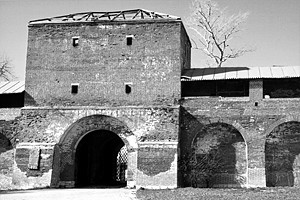 |
Zaraysk. Kremlin.
Nikol'skaya proezdnaya bashnya
(St. Nicholas drive-through tower).
Photo: A. Tilipman |
Zaraysk Kremlin, built 1528-1531 and well preserved till the present, is without any doubts the pearl of the town. Kremlin stands at the plateau by the confluence of Rivers Monastyrka and Osyotr, occupying South-West corner of the Ostrog, which once surrounded it. Of all Russian fortresses preserved till our time, Zaraysk Kremlin is one of the most compact structures - it has an area of just 2.3 hectares. The plan of Kremlin is geometrical: It is a rectangle oriented precisely to the cardinal points. At the corners 4 polyhedral towers are situated, and in the center of each side (except for the Eastern one) a square drive-through tower. To improve the communication with the town, an additional gate was breached in the Eastern wall in 1789. Currently, this gate provides the main access to Kremlin. The fortress is made of brickstone and from the exterior it is faced with the white stone up to 2/3 of the height of the ramparts and 3/5 of the height of the towers. The thickness and the height of the ramparts achieve 3 and 9 meters respectively. We do not know how the roofs of the tower looked originally; existing hipped roofs from boards were created in the course of restoration works in 1950s.
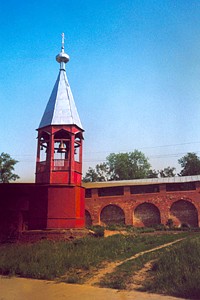 |
Zaraysk. Kremlin. Belfry.
Photo: I. Gurevich |
Among the buildings situated inside Kremlin, the most interesting one in both an architectural and a historical sense is five-domed columnless Nikol'sky Sobor (St. Nicholas Cathedral, 1681). The entire history of Zaraysk is directly related to ecclesiastical edifices built at the place of present-day St. Nicholas Cathedral. Some of those burned, others got dilapidated, the fate of the majority is only known very approximately. The first St. Nicholas Church was built in 1224, because a group of missionaries headed by Eustaphios arrived to Zaraysk from Korsun'. The missionaries did not come empty-handed: They brought an icon of St. Nicolas of Korsun'. According to a legend, in 1237 after the Princess Evpraksia zarazilas' - fell to her death - St. Nicholas of Korsun' was renamed into St. Nicholas of Zarazsk. Beyond any doubts, this story had a great educational and patriotic meaning, and to miss such an opportunity would be an unforgivable error of the missionaries. In any case, starting from 13th century, in St. Nicholas Cathedral they started to create the outstanding literary monument of Old Russia - a series of Povesti o Nikole Zarazskom ("Narratives on Nicholas of Zarazsk"), which include the "Narrative of the Ravaging of Ryazan' by Batu Khan". Priests of the cathedrals - Old Russian chronicler Eustaphios and his followers - Prokopy, Nikita, Vasilisk, Zakhary, Feodosy, Matvey, Ioann Visloukh and Petr - worked on the "Narratives" for 335 years. Tombs of these zealotes are around the cathedral.
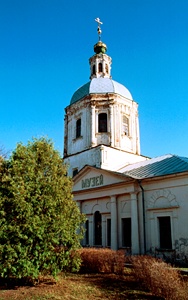 |
Zaraysk.
Troitskaya tserkov'
(St. Trinity Church).
Photo: A.Tilipman |
Sobor Ioanna Predtechi (St. John the Baptist Cathedral, 1901 - 1904) also has many predecessors. Some sources even claim that Prince Feodor, Princess Evpraksia, and their son Ioann - the same ones from 1237 - are buried under the altar of the cathedral. From the architectural point of view, the cathedral is in a strong dissonance with both St. Nicholas Cathedral and Kremlin.
Equally absurd-looking is the relatively recently built little wooden belfry, which during its not so long age managed to get considerably skewed.
Troitskaya tserkov' (St. Trinity Church, 1776-1788). The building of the church from 1930s to the present houses Zaraysk Museum of Art and History. The edifice was built in 16th century as the church of Krugly Monastery in Ostrog. That wooden church burned in 1774. The brickstone church preserved till our days was constructed from 1776 to 1788. A refectory in the classicist style was built in 1808 between the church and the belfry. The belfry of St. Trinity Church also has some Pisan inclinations.
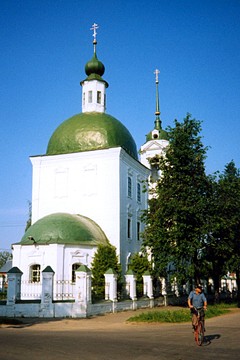 |
Zaraysk.
Blagoveshchenskaya tserkov'
(Annunciation Church).
Photo: I. Gurevich |
The construction of Blagoveshchenskaya tserkov' (Annunciation Church, 1777-1825) started 1777, and it was consecrated in 1795. The construction of three-tier bellfry falls into 1825. The church has a rectangular base, with one-dome columnless completion and low apse. The interior of the church is very spectacular due to the proportions of the building and the multi-tier iconostasis. Next to the church is the common grave of Arzamas volunteers, who were killed in 1608 in the fight for liberation of Zaraysk from the Polish army of Lisowski.
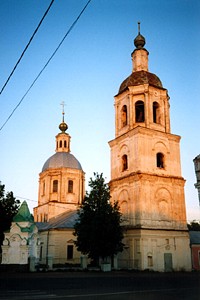 |
Zaraysk.
Troitskaya tserkov'
(St. Trinity Church).
Photo: I.Gurevich |
Il'inskaya tserkov' (St. Ilia Church, 1819-1835) is built of brickstone in the classicist style. From the Western side, it is connected to a big four-column refectory and a bellfry built in the pseudo-Russian style, partially rebuilt in the second half of 19th century.
Talking about civil buildings, among to most interesting ones we mention trading arcades (end of 18th century), inimitable water tower (1914), Civil Council (1910), Town Administration, and numerous dwelling houses from 19th century along Karl Marx and Dzerzhinsky streets.
Unfortunately, in recent years Zaraysk suffered a number of irreparable losses. Several unique monuments were either disassembled or burned under mysterious circumstances. Thus, the town map lost a wine store, which was already there in 1774. Apparently, the dwelling house (Dzerzhinsky street, 53), one of the most beautiful in Zaraysk, also stood up at somebody's way. Finally, an unique mansion in the modernist style, so called Reders dacha, burned mysteriously.
The question whether this was intentional or accidental, we leave outside the scope of this article.
|